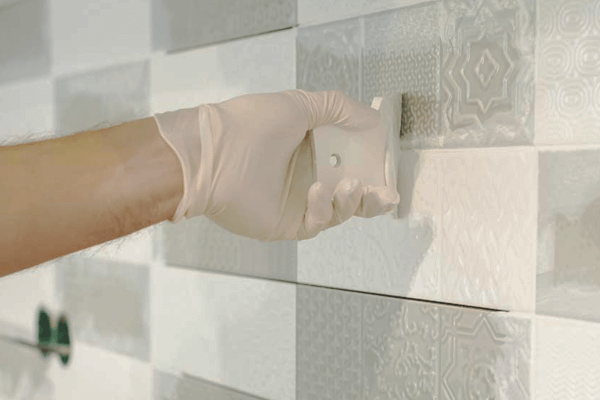Epoxy grout is a unique type of tile installation. Generally, it possesses an extreme chemical resistance and is considered more flexible than any regular cement grout; it is durable, can resist stain, and is fit for installations in places like Conference halls, restaurants, and household toilets. However, aside from being expensive, it is also difficult to apply. Epoxy grout can be used for any interior installation, using ceramic or natural stone tile. Most epoxy grout does not require sealing after installation and can easily be cleaned with just water.
Epoxy grout consists of epoxy resins combined with a filler powder. This cement-based mixed product is waterproof and stain-resistant. Also, it doesn’t crack, shrink or discolor. However, epoxy grout is the most difficult to install compared to other groups. It is time-consuming and requires utmost care when applying, and It also has to be applied in stages. Compared to the textured cement-looking regular grout, epoxy has a slightly plastic look.
Several reviews of epoxy grout show that epoxy grout is the best type of product for installation. Also, it is costly and difficult to work with. The question should be, are any of these claims true?

If you genuinely intend to seek knowledge and broaden your horizons about epoxy grout and its related problems, you will find this article very helpful.
Contents
Problems of Epoxy grout
Epoxy grout is undeniably an excellent product designed to suit users’ tastes. Although users are bound to experience a few problems when using the product, these problems can not be too much to handle.
Difficult working with
A very common problem constructors encounter is the difficulty associated with working with epoxy grout. When working with the epoxy grout, be time conscious because it dries very fast. Also, chemicals in the epoxy grout can cause discoloration if the work isn’t done fast and the epoxy grout isn’t wiped quickly and thoroughly.
Appeareance of pinholes
The appearance of the pinhole is also a common problem with epoxy grout. Epoxy grout often traps bubbles, and these bubbles eventually rise and pass through the top, causing pinholes. Air from the under of tiles that are not properly fixed can also cause Pinholes.
Epoxy grout is expensive
Epoxy grout is very expensive compared to other types of grout; the price of this product is double or costlier than the standard cement grout. Aside from that, applying the product is time-consuming and hectic.
The problems of Epoxy grout can not be too big to handle. With available products and alternatives, it is quite easy to address the problems of epoxy grout.
Solution to epoxy grout problems
As mentioned earlier, epoxy grout users might encounter certain problems, which are not too mighty to solve.
Clean the epoxy grout regularly
To respond to this problem, always ensure to scrub your epoxy grout immediately there is a stain; this helps to erase any dull appearance. Also, it is advisable to use these three most commonly used products: vinegar, bleach, and baking soda.
Vinegar
It contains high-level acid, which makes it easy to clean effectively, vinegar has proven to be very helpful when dealing with decoloration.
To use vinegar to clean epoxy grout, pour one cup of vinegar into a cup of warm water, soak a brush or mop in the solution, and then rub the grout lines with the brush or mop focusing on the ceiling and the floor. The next thing to do is wait for fifteen minutes before rinsing it with cold water. In the case of a mold, vinegar might not work; consider using bleach.
Bleach
Bleach is another product you can rely on to remove stains and molds from your grout. To use bleach, first, you have to mix a cup of bleach with a cup of liquid soap, then add a cup of water. After that, make sure to transfer the solution to a spray bottle. Spray the mixture on the walls or between your grout lines and scrub gently to remove stains or molds.
Baking soda
An alternative product that supports the removal of stain and any form of decoloration is baking soda. To use it, mix a little amount of baking soda with a little quantity of water until it forms a paste. After that, rub the mixture on the grout and wait for a few minutes before rinsing.
If the epoxy grout is expensive, consider trying an alternative
Not everyone can afford epoxy grout, not because it was designed to suit only the wealthy. Therefore, if you can’t afford epoxy grout, Acrylic Grout is another good option.
Acrylic grout is made of acrylic resins or urethane. It is resistant to stain, mold, debris, and chemicals like epoxy grout, is very durable, can last for over 10-20 years, and doesn’t need sealing. What differentiates Acrylic grout from epoxy grout is that epoxy grout is more expensive compared to Acrylic grout.
Furthermore, even though epoxy grout is stronger, acrylic is not as difficult to work with as epoxy grout. Like epoxy, acrylic is very suitable for hard vicinities. If you are looking for something cheaper, acrylic is another option for you.
Benefits of Using Epoxy Grout
Although epoxy grout has its disadvantages, it is no doubt a good product. The benefits of epoxy grout include:
It is durable
Epoxy grout is made out of resin and a hardener, making it strong and long-lasting; it can also hold moisture, debris, and any chemical. Furthermore, epoxy grout is produced in such a way that it can survive hard situations. It is also the best product for indoor and outdoor installation with a longtime guarantee.
It is resistant to moisture and stain
Epoxy grout can resist stains and moisture. It can easily remove stains like hair relaxers, ink stains, and specks of dirt; it prevents discoloration.
Final thoughts
So there you have it. Grout, without the scrubbing. Despite some of the problems of epoxy grout, it is the absolute choice to work within areas that experience high traffic and wet areas. If you want to install a mosaic splashback behind a cooktop or a light-colored floor tile, you can always opt for epoxy grout.
